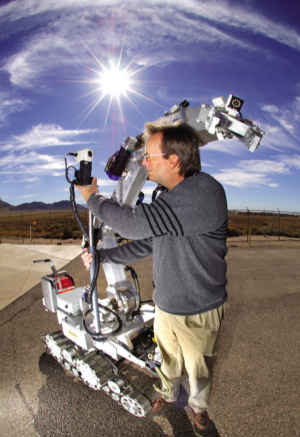December 18, 2005
Mighty Mouse
Cool story about a robot that saved the day. From Sandia National Laboratories comes this story of Mighty Mouse:‘Mighty Mouse’ robot frees stuck radiation sourceSome more details about the problem:
A Sandia National Laboratories robot recently withstood enough radiation to kill 40 men in freeing a stuck radiation source — the size of a restaurant salt shaker — at a White Sands Missile Range lab so that the cylinder could be safely returned to its insulated base.
The robot, for its successful efforts, was unofficially dubbed M2 for the cartoon character “Mighty Mouse.”
The operation — carried out by the robot and a joint task force of White Sands and Sandia RAP (Radiation Assistance Program) team members — ended 21 days of warning lights flashing and horns blaring at the 3,000-square-foot Department of Defense lab in Southern New Mexico.
The cylinder normally arrived and departed through a metal sleeve, driven by pneumatic air. The method resembled that used by drive-up banks, where pneumatic air drives a cylinder containing transaction paperwork first one way and then the other.
At White Sands, a pressure of approximately 20 psi was normally enough to move the container from its secure resting place to its forward exposed, or live, position; the same air pressure in the opposite direction sent it back. Over previous decades, on the rare occasions when the cylinder stuck, technicians had merely increased air pressure to send it on its way.
But this problem was different. From the safety of their control room, technicians increased air pressure in steps until they had reached 50 times normal, or 1000 psi, but they could not budge the cylinder. They speculated it had rammed into a signal switch that formed part of the sleeve’s pathway. In design, the switch resembled a teeter-totter. If the switch’s forward end was up when it should have been down, it would resist the cylinder’s passage. More air pressure would only insert the switch’s edge more deeply into the cylinder.
Range management considered its options.
On the positive side, gamma rays decreased in intensity by the square of the distance. That is to say, past a few hundred feet, the surrounding area was perfectly safe. And, unlike neutrons, the rays did not contaminate materials they touched; they were deadly only as they passed through a living organism.
On the negative side, the lab was shut down. It had to be manned around the clock to be sure no security guard wandered into the harmless-appearing area; meanwhile, the continually flashing lights and honking alarms set peoples’ teeth on edge.

Comments
Post a comment